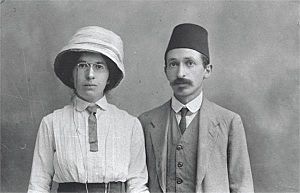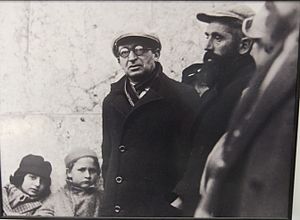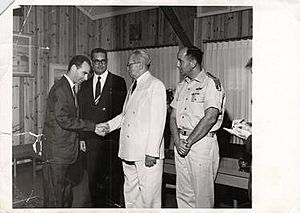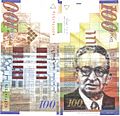Yitzhak Ben-Zvi facts for kids
Quick facts for kids
Yitzhak Ben-Zvi
יצחק בן־צבי |
|
|---|---|
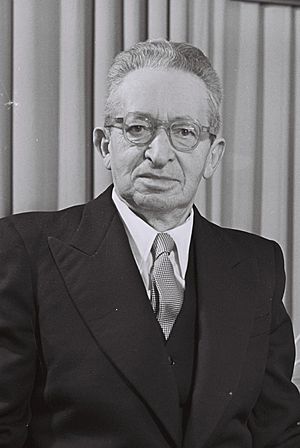
Ben-Zvi in 1952
|
|
| 2nd President of Israel | |
| In office 16 December 1952 – 23 April 1963 |
|
| Prime Minister | David Ben-Gurion Moshe Sharett David Ben-Gurion |
| Preceded by | Chaim Weizmann |
| Succeeded by | Zalman Shazar |
| Member of the Knesset | |
| In office 12 February 1949 – 8 August 1952 |
|
| Personal details | |
| Born | 24 November 1884 Poltava, Russian Empire (now Ukraine) |
| Died | 23 April 1963 (aged 78) Jerusalem, Israel |
| Nationality | Israeli |
| Political party | Mapai |
| Spouse | Rachel Yanait |
| Children | 2 |
| Alma mater | Istanbul University Faculty of Law |
| Signature |  |
Yitzhak Ben-Zvi (Hebrew: יִצְחָק בֶּן־צְבִי Yitshak Ben-Tsvi; 24 November 1884 – 23 April 1963) was an important leader in the Labor Zionist movement. He was also a historian and ethnologist. Ben-Zvi served as the second and longest-serving President of Israel.
As a scholar, Ben-Zvi studied Jewish communities living in the Land of Israel. This included groups that were there long before the modern State of Israel was founded. He collected stories, personal accounts, and documents. He wrote many books and articles about these communities. His work often focused on Mizrahi and Sephardic Jewish people, as well as the Samaritan community. He helped people learn about their traditions, languages, folklore, and religious customs. The Ben-Zvi Institute, which he started, is still a key place for research on Jewish communities in the Middle East.
Contents
Early Life and Family
Yitzhak Ben-Zvi was born in Poltava, which was part of the Russian Empire (now Ukraine). He was the oldest son of Zvi Shimshelevich, who later changed his name to Shimshi. His father was a member of the B'ne Moshe and Hovevei Zion movements. He helped organize the first Zionist Congress in Basel, Switzerland, in 1897. At this meeting, the World Zionist Organization was created. They announced their goal to re-establish a Jewish state.
Shimshi was the only organizer of that first Zionist Congress who lived to see the State of Israel born in 1948. In 1952, the Israeli parliament (Knesset) honored Zvi Shimshi. They gave him the title "Father of the State of Israel."
Yitzhak Ben-Zvi's parents were sent away to Siberia. This happened after weapons he had hidden in their home were found. Yitzhak's brother, Aharon Reuveni, became a writer. His brother-in-law, Benjamin Mazar, was a famous Israeli archaeologist.
Ben-Zvi received a traditional Jewish education. He attended a heder (Jewish elementary school) and a Gymnasium (high school) in Poltava. He studied natural sciences for a year at Kiev University. However, he left to focus on the Russian Poale Zion movement, which he helped start.
In 1918, Ben-Zvi married Rachel Yanait, who was also a Poale Zion activist. They had two sons, Amram and Eli. Sadly, Eli died in the 1948 Arab–Israeli War. He was defending his kibbutz, Beit Keshet.
Becoming a Zionist Leader
After another leader, Ber Borochov, was arrested, Ben-Zvi became the head of the Russian Poale Zion in 1906. He moved their main office to Vilna and started a publishing house. This house produced the party's newspaper. In 1907, Ben-Zvi moved to Palestine. He had been arrested twice and was watched by the secret police. He used fake papers to travel. This was his second visit to Palestine. When he arrived in Jaffa, he changed his name to Ben-Zvi, meaning "Son of Zvi."
He found the local Poale Zion group disorganized. Being a bit older and more experienced, he took charge. The next month, he organized a meeting of about 80 members. He and another member were chosen for the new Central Committee. They decided to publish a party newspaper in Yiddish. Ben-Zvi and Israel Shochat also attended the 8th World Zionist Congress in The Hague.
Later, in 1907, Ben-Zvi helped create a secret military group called Bar-Giora. This group was named after Simon Bar Giora. Their motto was: "Judea fell in blood and fire; Judea shall rise again in blood and fire." The next year, Ben-Zvi was one of the people who started Hashomer, another defense organization.
In 1910, Ben-Zvi helped start a Socialist Hebrew newspaper in Jerusalem called Ha'ahdut. He convinced David Ben-Gurion to join as a proofreader. In 1911, Ben-Zvi decided to move to Constantinople to study Ottoman law. Many other Zionist activists also gathered there.
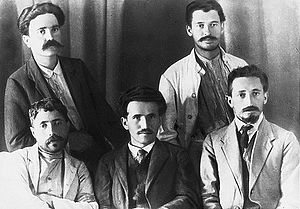
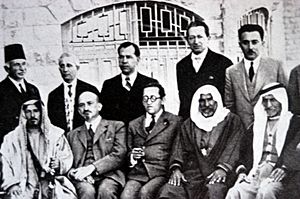
During World War I, Ben-Zvi and Ben-Gurion were sent away to Egypt. From there, they went to New York. In America, they worked to educate people about Jewish settlement projects in Palestine. This led to their book Eretz Israel - Past and Present (1918). It sold many copies.
After returning to Palestine, Ben-Zvi married Rachel Yanait. In 1919, he helped found the Ahdut Ha'Avoda party. He helped change it into a Social Democratic party. Ben-Zvi knew Arabic well, so he was in charge of policies related to Arab communities. He believed that Zionism could benefit the local population. Between 1925 and 1928, he produced an Arabic language Zionist newspaper called al-'Umma (Workers Unity). In 1931, he became the chairman of Va'ad Leumi, which was like a shadow government for the Jewish community.
Ben-Zvi also served in the Jewish Legion (1st Judean battalion 'KADIMAH') with Ben-Gurion. He became very active in the Haganah, a Jewish defense organization.
Political Career
Ben-Zvi was elected to the Jerusalem City Council. By 1931, he was the president of the Jewish National Council. This council acted as the government for the Jewish community in Mandatory Palestine. When Israel became an independent state on May 14, 1948, Ben-Zvi was one of the people who signed its Declaration of Independence.
He served in the first and second Israeli parliaments (Knesset) for the Mapai party. In 1951, Ben-Zvi was part of the Government Naming Committee. This committee decided on names for new settlements being built in Israel.
Teaching and Research
In Jaffa, Ben-Zvi worked as a teacher. In 1909, he helped organize the Gymnasia Rehavia high school in Jerusalem with Rachel Yanait.
In 1948, Ben-Zvi led the Institute for the Study of Oriental Jewish Communities in the Middle East. This institute was later named the Ben-Zvi Institute (Yad Ben-Zvi) in his honor. His main research area was Jewish communities and groups in Asia and Africa. This included the Samaritans and Karaites.
Studying the Samaritans
Ben-Zvi had a special connection with the Samaritan community. He first met Samaritans in 1908. He rented a room from Abraham son of Marhiv Zeadaka Hazafrir in Jaffa to learn Arabic. He became very interested in the Samaritans. He made friends with their High Priests, leaders, and scholars. He visited them and exchanged letters.
After learning Arabic and Samaritan Hebrew, he decided to study the Samaritans in depth. He researched their religion, writings, and where they lived. As a historian, he published a book about the Samaritans in 1935. As a leader, Ben-Zvi was seen by the Samaritans as someone who could help with their concerns. David Ben-Gurion also learned about the Samaritans from Ben-Zvi. He supported the Samaritans living in Israel.
Presidency
Yitzhak Ben-Zvi was elected President of Israel on December 8, 1952. He officially started his job on December 16, 1952. He remained president until he passed away.
Ben-Zvi believed the president should be an example for everyone. He thought his home should show the simple way of life of the time. For over 26 years, he and his family lived in a simple wooden hut in the Rehavia neighborhood of Jerusalem. The State of Israel later bought the house next door to give the President's residence more space. Two larger wooden buildings in the yard were used for official meetings.
Awards and Recognition
In 1953, Ben-Zvi received the Bialik Prize for his work in Jewish thought.
Ben-Zvi's picture appears on the 100 NIS banknotes. Many streets and boulevards in Israel are named after him. In 2008, Ben-Zvi's wooden hut was moved to Kibbutz Beit Keshet. This was the kibbutz his son helped to found. The inside of the hut was restored to look as it did originally. The Valero house in Rehavia, which was next to his hut, is now a protected historic building.
Published Works
- Sefer HaShomronim [Book of the Samaritans] (1935)
- She'ar Yeshuv (1927)
- Yehudey Khaybar veGoralam [The Jews of Kheibar and their fate] (1940)
- Coming Home, translated from Hebrew by David Harris and Julian Metzer (Tel Aviv, 1963)
- Derakhai Siparti, (Jerusalem, 1971)
Images for kids
-
Private Yitzhak Ben-Zvi as a volunteer in the Jewish Legion, 1918
-
100 Israeli new shekel bill
See also
 In Spanish: Itzjak Ben-Zvi para niños
In Spanish: Itzjak Ben-Zvi para niños
- List of Bialik Prize recipients


